Karl Shuker's Blog, page 65
June 11, 2012
LOCH WATTEN'S MISSING MONSTER - WHATEVER HAPPENED TO WATTIE?

"It was a bright spring day, and steely sunshine glinted over the mountains of Caithness when Colonel Arthur Trimble first saw the monster of Loch Watten.
"The monster’s eyes were slits in a huge squat head, and its body, which loomed under the rippling water, appeared at least 20 feet wide. It observed him for several seconds. He even had time to take a photograph of it. "
John Macklin – ‘The Trap He Set Was For A Monster...’,
Leicester Mercury, 28 March 1966.
I first learnt about the existence of winged cats – which subsequently became an investigative passion of mine - when, as a teenager, I read a fascinating little book by prolific author Peter Haining entitled The Monster Trap and Other True Mysteries (1976). That same book introduced me to a couple of other subjects that I have since pursued in depth too – the Green Children, and the mysterious mini-mummy of Wyoming.
Ironically, however, the chapter that interested me most of all (and which gave its title to the entire book) was also the one that has mystified me most of all – because, over 35 years later, and in spite of the fact that it is potentially of immense cryptozoological significance, its subject has resisted every attempt made by me to uncover any additional details regarding it. Consequently, I feel that it is now time to give this whole perplexing matter a long-overdue public airing online.
THE (VERY) MYSTERIOUS CASE OF THE MONSTER TRAP
The setting for the truly extraordinary episode documented in this chapter is Loch Watten – a Scottish freshwater lake in Caithness’s River Wick drainage system. Its grim tale as given in Haining’s book (in which the chapters’ stories, although all allegedly true, are written up in a dramatised, novel-like style) can be summarised as follows.
According to Haining, the incident in question took place some 10 years before the flap of Nessie sightings in 1933, and featured local estate owner Colonel Arthur Trimble (who had retired in 1922 from the British army). It all began on the morning of 21 April 1923, when Trimble was walking his spaniel, Bruce, by the lochside, not far from his estate. He had a camera with him, as it was a pleasant morning and he hoped to take some photographs. After reaching his usual point for turning back, Trimble called to Bruce, who had run some distance further ahead, and after waiting for him to come back, Trimble looked out across the loch – where, in Haining’s words:
"Something dark and looming had suddenly appeared on the surface of the water.
"The Colonel squinted his eyes and raised his hand to half-shade his face. The form was clearer now. It looked like a kind of neck with a huge flat head.
"Keeping quite still, he looked harder and could see that it was indeed a head and neck, and that there were slit eyes staring directly at him. Below the surface of the water he could make out the shape of an immense body, at least twenty feet wide.
"Colonel Trimble could hardly believe the evidence of his senses. It seemed like some huge water monster."
Haining stated that although the monster was less than a hundred yards away, thanks to his years of army discipline Trimble did not panic, and lifted his camera. Just as he was about to take a photograph, however, his dog Bruce spied the monster and immediately ran towards it, barking loudly. Startled, the monster disappeared beneath the water almost at once, but at that same instant Trimble succeeded in snapping a single photo, although he had no idea whether he had actually captured the beast’s image. When he and Bruce arrived back home and he told his housekeeper, a local woman called Mrs Doris Dougal, what had happened, she confirmed that he had seen the loch’s legendary ‘serpent’, and suggested that he report his sighting.
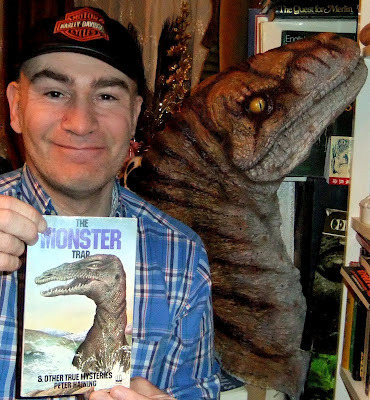 With my copy of The Monster Trap (and an interested Velociraptor looking on...) (Dr Karl Shuker)
With my copy of The Monster Trap (and an interested Velociraptor looking on...) (Dr Karl Shuker)That same day, Trimble took his camera’s film to the local chemist shop for developing, and when he collected his photos two days later he was delighted to discover that although the picture snapped by him at the loch was slightly blurred, it did indeed depict the monster’s head and neck above the water surface. Consequently, that afternoon he penned an account of his sighting for London’s Times newspaper, enclosed with it a copy of his photograph, and posted it a few hours later. From then on, Trimble visited the loch daily, in the hope of seeing and photographing the monster again, but leaving Bruce at home to ensure that he didn’t cause any disturbance this time if the monster should reappear.
Unbeknownst to Trimble, however, on 1 May, while he was once again at the loch, Bruce managed to sneak out, and when Trimble returned home later that day he was met by Mrs Dougal with the disturbing news that Bruce was missing. The two of them spent some time searching for the dog locally, but to no avail – until Trimble saw a man approaching from the direction of the loch. The man was Trimble’s nearest neighbour, the local doctor Robert McArdish, who told Trimble that he had spied Bruce swimming in the loch – but just as the doctor had been about to call out to him, he had seen a flurry in the water, as if something else was also there, and then the dog disappeared, after which the waves settled again, but with no sign of Bruce.
Enraged by the apparent killing of his dog by the monster, the following day Trimble set about building an extraordinary ‘monster trap’, consisting of 50 fathoms of rope attached to an enormous sharpened spike of steel that had been shaped into a massive hook. Trimble baited this hook with a large piece of freshly-purchased horsemeat, and after rowing into the middle of the loch in his dinghy he lowered the hook into the water, attached a marker buoy to the end of the rope, and dropped it overboard. Then he rowed back to shore, and returned home.
The next morning Trimble went out to inspect the trap, but it had not been touched, so he repositioned it elsewhere in the loch, and came back home. This procedure was repeated up until the evening of 4 May, when he informed Mrs Dougal that he was going out to the loch again, even though it was almost dark. Just on 9.30 pm, after looking outside to see whether he was returning as he was late, Mrs Dougal suddenly heard a single loud, terrified scream, from the direction of the loch. Racing outside to the gardener’s cottage close by, she hammered on his door, explained what had happened, and the two of them ran fearfully to the loch. There, in some reeds at the lochside, was the half-submerged body of Trimble, and as they looked down at it, they saw to their horror that his chest had been pierced by the giant hook, which was still attached to the rope. And as they stood there, they heard something:
"…something that turned their blood to ice – and haunted them for the rest of their days.
"It was a sound which came from the loch. The sound of something large that splashed as it swam away from the shore... "
And with that dramatic little flourish, there endeth Haining’s tale of the Loch Watten monster (let’s call it Wattie, for short).
WHITHER WATTIE?
Needless to say, one would imagine that such an episode, far more sensational than anything that even Nessie can lay claim to, would have subsequently featured in every major (and minor!) cryptozoology publication as a matter of course, as famous – or infamous – as the story of the Surgeon’s Photograph and other endlessly rehashed and recycled cryptozoological histories. Yet nothing could be further from the truth.
Indeed, I have yet to discover a single mention of the Wattie history anywhere – I know of no book, periodical paper, magazine article, newspaper report, or website that contains even the briefest reference to it. Moreover, the only acknowledged claim to fame of Loch Watten, other than having been formally designated as an SAC (Special Area of Conservation), is that it is a good body of water for fly-fishing for brown trout. In stark contrast, any celebrity status as a monster-haunted lake is conspicuous only by its absence. So how can such anomalies be explained?
Let’s look at would use stories that had particularly fascinated me in which I had done considerable research, if not actually visited the places in question.t some background information, beginning with a few additional details supplied by Haining himself. In his book’s introduction, he stated that when selecting stories to be covered by him in it, he didn’t want to repeat ones that lots of other writers had already utilised. Instead, he decided:
"Consequently, I feel that it is now time to give this whole perplexing matter a long-overdue public airing."
Furthermore, in the opening to the ‘Monster Trap’ chapter itself, he stated that although Nessie was certainly the most famous Scottish monster, she was not the only one, noting that there were stories of water horses and serpents from many other Highland lochs, and then commenting:
"One particular monster story has always fascinated me, but amid all the fuss about ‘Nessie’ it rarely gets mentioned."
For ‘rarely’, substitute ‘never’!
Yet according to Haining’s book, local people claim that there have been stories of a monster, which they term ‘the serpent’, in Loch Watten for many years, but no documentary records of actual sightings prior to Trimble’s ultimately fatal incident. Is this true? Never having visited the loch myself, which is only 14 miles from John O’Groats in the far northeast of Scotland, I have no idea whether there is any verbal tradition of a monster here (though I have yet to communicate with anyone versed in Scottish mythology or cryptozoology who has ever heard of such tales). However, I would have expected at least some documentation of it, were such a tradition to exist. After all, as Haining correctly pointed out, there are accounts of monsters for a number of other lochs – including Ness, Morar, Oich, Lochy, Shiel, Arkaig, Lomond, Beiste, Quoich, and Trieg.
 Loch Watten (Wikipedia)
Loch Watten (Wikipedia)Another anomaly concerns Loch Watten itself. Despite being the second largest of Caithness’s lochs, it is under three miles (4.65 km) long, less than a mile (1.6 km) across at its widest point, and boasts an average depth of only 10-12 ft (2.5-3.0 m) – a very far cry from the immeasurably greater size of Loch Ness, Loch Morar, and other notable bodies of Scottish freshwater associated with monster traditions. If the kind of huge reptilian monster (at least 20 ft wide – so how long was it?!) allegedly encountered by Trimble were truly real, it would surely require a much more substantial aquatic domain than Watten.
Nor do these inconsistencies constitute the full extent of my concern for the validity of Wattie as a bona fide cryptid. When I first attempted to research this subject, back in the early 1990s, I wrote on two separate occasions to Haining, having obtained his correct address, but I never received a reply to my requests for information, and as he died in 2007 this most direct line of investigation is no longer an option. In addition, I met with a succession of dead-ends when attempting to uncover any Trimble-related leads (not even trawling through death registers and army records online elicited any evidence for his supposed former existence). I also searched meticulously through the relevant period of back issues for The Times, but did not find any published letter or photo by Trimble.
 Peter Haining (picture source unknown to me)
Peter Haining (picture source unknown to me)In short, the only known source of information (to me, at least) concerning Wattie is Haining’s book, and, therefore, Haining himself – which to my mind is the most disturbing aspect of all concerning this mystifying tale. The reason why I say this is that some of Haining’s other publications have already attracted considerable controversy in relation to the validity – or otherwise – of their claims.
SPRING-HEELED JACK, SWEENEY TODD, AND WOOLPIT’S GREEN CHILDREN – THREE REASONS FOR WATTIE WORRIES
For example: in a detailed paper on Spring Heeled Jack (Fortean Studies, vol. 3, 1996), Mike Dash revealed that he was unable to obtain independent corroboration of various accounts and details that had been published by Haining in his book on this subject (The Legend and Bizarre Crimes of Spring Heeled Jack, 1977). And even an engraving claimed by Haining to show the recovery from a marsh of one of Jack’s victims – a victim, incidentally, undocumented by anyone else – in reality showed no such thing.
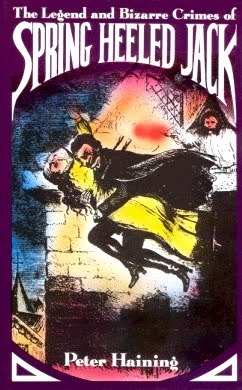
Moreover, when Mike Dash wrote to him asking for sources, Haining replied that he was unable to supply any because all of his research material had been loaned to a film scriptwriter who had subsequently vanished. Not surprisingly, perhaps, in his paper’s annotated bibliography, Mike made the following comments regarding Haining’s book:
"The only full-length work on the subject is a curious hodge-podge of the accurate, the overtly-dramatised and the invented...it repeats many existing errors, creates new ones, and is so single-mindedly determined to fit evidence to the theory that Jack was the Marquis of Waterford that it does not flinch from introducing made-up evidence to support this case."
Equally controversial are Haining’s books on Sweeney Todd, Fleet Street’s homicidal hair-snipper. Although Todd is widely assumed to be an entirely fictitious character spawned by the Penny Dreadfuls of Victorian times, Haining published two book-length treatments, respectively entitled The Mystery and Horrible Murders of Sweeney Todd, the Demon Barber of Fleet Street (1979) and Sweeney Todd: The Real Story of the Demon Barber of Fleet Street (1993), in which he alleged that such a person had actually existed.
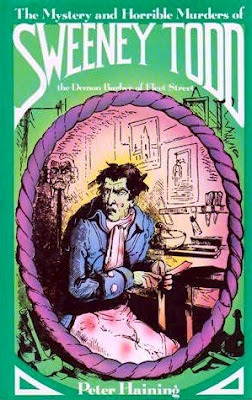
However, this claim has attracted much criticism, for a variety of reasons, including those summarised succinctly in Wikipedia’s entry for Haining [as most recently accessed by me today, 11 June 2012]:
"In two controversial books, Haining argued that Sweeney Todd was a real historical figure who committed his crimes around 1800, was tried in December 1801, and was hanged in January 1802. However, other researchers who have tried to verify his citations find nothing in these sources to back Haining's claims. A check of the website ‘Old Bailey’ for "Associated Records 1674-1834" for an alleged trial in December 1801 and hanging of Sweeney Todd for January 1802 show no reference; in fact the only murder trial for this period is that of a Governor/Lt Col. Joseph Wall who was hanged 28 January 1802 for killing a Benjamin Armstrong 10 July 1782 in "Goree" Africa and the discharge of a Humphrey White in January 1802."
In short, there are notable precedents when faced with questioning the reliability of claims made by Haining in the absence of any independent sources of evidence to examine. Even in another chapter of The Monster Trap, documenting the Green Children, it is curious to note that the famous, historically-recorded incident of the Woolpit Green Children receives no mention whatsoever. Instead, Haining devotes the entire chapter to an exceptionally similar version allegedly occurring several centuries later in Spain – a version subsequently revealed by other researchers to be a complete fabrication, by person(s) unknown, directly inspired by the Woolpit episode.
And I hardly need point out that Haining’s description of Trimble’s supposed photo – slightly blurred but showing a head and neck – is more than a little reminiscent of the Surgeon’s Photograph of Nessie. Also worth remembering is that aside from his non-fiction books, Haining was a well-respected, extremely knowledgeable anthologist of horror and mystery short stories of fiction.
WAS THERE EVER A WATTIE? OVER TO YOU!
It gives me no pleasure whatsoever in questioning the legitimacy of the Wattie affair as documented by Haining, especially as the book in which it appears is one that has been instrumental in introducing to me various other subjects that have since become significant in my own researches – and I would therefore be delighted if my concerns regarding this case could be convincingly dismissed. Yet it is clear that the omens for Wattie’s validity are not good.
Nevertheless, it would be rash to deny this tantalising tale out of hand without having first given an opportunity for it to be investigated publicly. So here, gentle readers, is where you come in. If there is indeed anyone out there with direct or indirect, integral or background information relating in any way to monsters reported from Loch Watten, and to the Trimble incident in particular, I’d love to hear from you.
Similarly, if Haining’s research files have been preserved, any details of where and whether they can be accessed would be very welcome. After all, if we are to believe his claim that all of the subjects in his book were ones in relation to which he had conducted considerable research, these archives undoubtedly offer the most likely source of primary and additional data concerning this most monstrous of Scottish crypto-mysteries.
FOUR WATTIE UPDATES
The publication by Fortean Times in issue #253 (September 2009) of my Wattie article, forming the basis of the above account of mine, has triggered four notable responses to date.
The first of these was an email of 28 August 2009 that I received from Rod Williams of Talgarth, Wales:
"I am a regular reader of Fortean Times and your item on Wattie was interesting but feel that it was a concocted tale by Peter Haining.
"I have read Hugh Miller's Scenes and Legends of the North of Scotland and also Samuel Smiles’s biography of Robert Dick [Robert Dick, Baker of Thurso, Geologist and Botanist, 1878], baker, biologist (botanist mostly) and geologist. A man who walked many miles at night over large parts of Caithness.
"I cannot recollect in either book mention of Loch Watten or a/its monster. Both men were not above mentioning curious tales, particularly Miller who was well into hauntings and weird happenings; apart from being a quarryman turned geologist he seemed to thrive on such tales.
"I may have missed any reference of course but the book of Miller's can be read on line for free should you wish to check it out.
"Not sure of Dick's biography being on line but probably is.
"George Borrow's Wild Wales (circa 1854) mentions 'crocodiles' in Welsh lakes or rather stories of these mythical beasts and enquires of people on his journey whether they knew of any local legends relating to these little lakes and crocs.
"Again I don't remember any specific stories as it has been many years since reading the book. I think I need to re-read it sometime.
"Our local lake Llangorse Lake has large pike in it and one chap told me that when he was wind surfing and was stood in the lake (shallow in many places) something large brushed his leg."
Quite apart from confirming the absence of Wattie information from some literary sources new to me, Rod’s email is also of value for the interesting snippets of information concerning Wales’s mystifying water ‘crocodiles’, which I’ve read about in a number of publications and which deserve a detailed examination in their own right.
The second response was a letter penned by German cryptozoologist Ulrich Magin, which was published by FT in November 2009. In his letter, Ulrich revealed that Haining’s account of Wattie was almost identical to a tale included by French fiction writer George Langelaan in Les Faits Maudits (not Maufits – as erroneously titled in Ulrich’s letter) or ‘Cursed Facts’ - a book of forteana published in 1967, containing an eclectic mixture of retold press clippings and fictional stories. Langelaan claimed that his source for that particular tale was a Times news report from May 1932, but a search for it undertaken by Ulrich failed to unearth any such report.

The third, and most significant, response was a letter that I received from FT on 31 March 2010, which had been written to me on 23 March by Lance Shirley of Cornwall and was accompanied by a remarkable enclosure – a photocopy of an article that had been published in the Leicester Mercury newspaper on 28 March 1966 in what appears to have been a regular, long-running series of articles published under a ‘Stranger Than Fiction’ banner. Written by a John Macklin, the article was entitled ‘The trap he set was for a monster...but it was the colonel who died’. Reading it through, I discovered that its content and wording were so similar to Peter Haining’s chapter The Monster Trap that it seemed highly likely either that Haining had directly copied Macklin’s account or that he and Macklin were one and the same person.
 Portion of the Leicester Mercury story by John Macklin (Leicester Mercury)
Portion of the Leicester Mercury story by John Macklin (Leicester Mercury)As I learnt from Mike Dash, Haining is known to have written under various pen-names as well as his own, so could John Macklin be yet another one? After receiving Lance’s letter and enclosure, I googled John Macklin on the internet, and discovered that just like Haining, he is/was a prolific author, and, again just like Haining, has authored many popular-format compilation books of supposedly true mysteries. Just another coincidence?
In his letter to me, Lance mentioned that he and his family had lived in Caithness, near to Loch Watten, from 1966 to 1976, during his childhood. While still living there in the early 1970s, he had read the Leicester Mercury article, which had belonged to his mother (it had been forwarded to her for its interest value from her father, who lived in Loughborough and always bought this newspaper), and was excited to think that such a creature may live so close to them. Whenever they passed the loch in the car, they always scanned the surface, just in case they could catch sight of the monster. Upon reading my FT Wattie article in September 2009, Lance realised that Haining’s account matched what he could still recall from that newspaper cutting from long ago. Moreover, while subsequently clearing out the loft in the family home, he was delighted to discover it, yellowed with age but still intact, stored inside a biscuit tin crammed with other cuttings (including another John Macklin ‘Stranger Than Fiction’ article from the Leicester Mercury, this time dating from 1969 and documenting a ghostly occurrence in Hoy Harbour).
As Lance points out, what is so interesting is that the Leicester Mercury article predates not only Haining’s book (by 10 years) but also that of George Langelaan (by a year). Consequently, it now seems that Langelaan did not originate this tale after all. Regardless of who did do so, however, no independent, substantiating evidence for its veracity or the existence in Loch Watten of a mysterious creature has ever come forward. Consequently, in my opinion the most reasonable conclusion remains that Wattie is a complete invention.
Irrespective of this, after receiving Lance’s letter I lost no time in pursuing the Macklin line of investigation further. My ultimate goal was the procurement of some current contact details if he is still alive (in which case, of course, he and Haining could not be the same person!); or, if he is dead, uncovering as much biographical information concerning him as possible, in the hope of determining conclusively whether or not John Macklin was indeed merely another pen-name of Peter Haining.
In April 2010, I emailed an enquiry to Macklin regarding Wattie via Sterling, the American publisher of the most recent Macklin book that I have yet been able to trace (a children’s book of true ghost stories, published by Sterling in 2006). So far, however, I have yet to receive any response from him.
Moreover, to me it seemed undeniably thought-provoking that whereas Macklin and Haining are/were both extremely prolific authors who wrote on extremely similar subjects, none of Macklin’s works are cited in the bibliographies of any of Haining’s books accessed by me (or vice-versa). Equally, I have been unable to trace any indication that Macklin has published any books or articles in the years following Haining’s death. And whereas photos of Haining are readily obtainable by googling his name, Google is currently (as of May 2010) unable to locate a single photograph of Macklin. Also, whereas Haining has a detailed entry in Wikipedia, Macklin (despite being a comparably prolific – and hence successful - author) has no entry whatsoever.
So were Haining and Macklin the same person, with Wattie merely the figment of an inordinately prolific writer’s fertile imagination? I was soon to discover the answer, which provided yet another unexpected surprise.
 Jonathan Burton's wonderfully atmospheric painting from my Fortean Times Wattie article of September 2009 (Fortean Times/Jonathan Burton)
Jonathan Burton's wonderfully atmospheric painting from my Fortean Times Wattie article of September 2009 (Fortean Times/Jonathan Burton)On 8 May 2010, I received the fourth response to my enquiry for Wattie information. This time it was a highly illuminating email from none other than FT’s own Paul Sieveking, who informed me that John Macklin was indeed a pseudonym – but not of Peter Haining! Instead, it was one of many pen-names used by another author of popular-format writings on mysteries – Tony James. The plot thickens! So did Tony James originate the storyline for the Wattie tale, or is there an even earlier version out there somewhere that he had read? If anyone has current contact information for James, I’d like to hear from you!
Meanwhile, my sincere thanks go to Rod Williams, Ulrich Magin, and especially Lance Shirley and Paul Sieveking for shining some important light upon this increasingly complicated mystery, and I am intrigued to see if any new developments will occur in the future. After all, as a certain cult television series used to proclaim, the truth is out there – it’s finding it that’s the problem!
REFERENCES
DASH, Mike (2010). Pers. comms, 1 & 2 April.
HAINING, Peter (1976). The Monster Trap and Other True Mysteries. Armada (London).
LANGELAAN, George (1967). Les Faits Maudits. Encyclopédie Planète (Paris).
MACKLIN, John (1966). The trap he set was for a monster...but it was the colonel who died. Leicester Mercury, 28 March, p. 7.
MAGIN, Ulrich (2009). Wattie. Fortean Times, no. 255 (November): 69.
SHIRLEY, Lance (2010). Pers. comms, 23 March & 2 April.
SHUKER, Karl P.N. (2009). In search of the missing monster. Fortean Times, no. 253 (September): 52-55.
SIEVEKING, Paul (2010). Pers. comm., 8 May.
WILLIAMS, Rod (2009). Pers. comm., 28 August.

This ShukerNature blog post is extracted from my book Karl Shuker's Alien Zoo: From the Pages of Fortean Times (CFZ Press: Bideford, 2010)
Published on June 11, 2012 12:21
June 5, 2012
ENCANTADO - SINISTER WERE-DOLPHINS OF THE AMAZON
 Encantado in mid-transformation (Tim Morris)
Encantado in mid-transformation (Tim Morris)It may be the 21st Century – an ultra-technological age of cyberspace, DNA analyses, and subatomic particle physics - but the old traditions have far from vanished. In countless cultures worldwide, there still exists a tenacious, deep-rooted belief in therianthropy – the supposed ability of certain humans to transform themselves into animals. Werewolves are perhaps the most famous example, but many others are on record, including were-leopards, were-crocodiles, were-pigs, were-tigers, and were-hyaenas, to name but a few. One of the most extraordinary, however, are the encantado – the ‘enchanted ones’ – whose reality is still fervently asserted in many parts of South America, including Peru, Venezuela, and, especially, Brazil.
Indeed, so potent is the fear of these supernatural shape-shifters in certain regions, such as the states of Joao Pessoa and Rio Grande do Norte in northern Brazil, that riverside inhabitants refuse to walk anywhere near the Amazon or its tributaries at certain times of the evening for fear of encountering them. But even this does not guarantee safety, because the encantado are very attracted to human festivals, carnivals, outdoor parties, and other sources of music and dance. They are also very attracted to pretty young human women, and it is said that encantado in human guise will often attempt to infiltrate such gatherings to dance and then steal away into the night with the prettiest women, often never to be seen again – or at least never seen again in a sane state, or even alive...
But what, precisely, are the encantado? Drawing together the many diverse strands of traditional Brazilian encantado legend and lore, here is my recreation of a typical encounter with these sinister beings, in which you will discover their astonishing secret.
The evening was warm and heady with the scent of night-blooming jungle flowers, the sounds of laughter and music drifted far upon the sultry breeze, and in every direction was a dazzling riot of colour, from the vivid costumes of the dancers to the rainbow-hued extravaganza of the gaudy decorations festooning the tree-lined streets and town square. It was Carnival in this little Brazilian town that looked out upon the banks of the mighty Amazon River, but in spite of the all-encompassing gaiety and fervour, Angel saw only Maria, the beautiful young woman to whom he was betrothed, and who would soon become his bride.
Whereas the others were garbed in shades of every conceivable hue, like a veritable flock of parakeets as they whirled and dipped and twirled to the lively rhythms of the dance, Maria, dressed entirely in white, resembled a divine bloom of Heaven. Or at least she did in Angel’s eyes – but then again, he was very much in love with her, and had been ever since they had first met a few months earlier, when she had arrived in his town.
Maria had been part of a fact-finding mission, sent here from the American university where she had recently graduated, but what she had found was Angel – and in no time at all had realised that she had no wish to return to America. All that she wanted now was here, because all that she wanted now was Angel. Within just a couple of weeks they had become engaged, and, tonight, only two more weeks separated them from their wedding.
All of this and more was filling Angel’s mind, so much so that he was momentarily distracted, and when he looked back at Maria he was startled to see that she was no longer with the other young women but was dancing to one side with a stranger – a man who looked of similar age to Angel and, like Maria, was dressed entirely in white. However, he was also wearing an extremely large wide-brimmed hat, which not only covered the whole of his head but even curved over his brow, right down to the level of his eyes. Where had this stranger come from?
Burning waves of jealousy rolled through Angel’s soul as he stood up, but so too did a disconcerting chill of fear that he couldn’t explain, yet which clutched his heart in a grip of icy dread. He moved towards the dancing couple, and as he neared them, the stranger abruptly turned, as if he had sensed Angel’s approach even without seeing him. With fury in his eyes, Angel met those of the stranger, and was shocked to see that they glowed with a vivid emerald hue, as green as the jungle-reflecting waters of the Amazon that flowed beside the town’s outskirts.
Suddenly, Angel’s mind started to swim, drifting and spinning like a shed leaf caught in the current of a fast-flowing stream. Colours and sounds danced before him, dazzling his eyes and reverberating in his ears until he had to lean against one of the carnival stalls to steady himself. After a while, his senses cleared again, and he looked around for Maria, but she was nowhere to be seen – and nor was the stranger...though this did not worry Angel, because he no longer had any recollection of him.
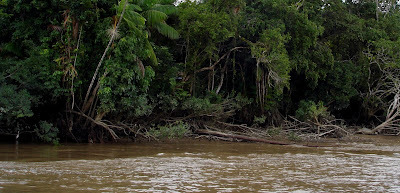 The Amazon River (Wikipedia)
The Amazon River (Wikipedia)The path leading down to the river, fringed with trees and bushes, was cool and still, very different indeed from the heat and the noise of Carnival that they had left behind. Maria walked beside the stranger, and although no words passed between them it felt to her as if she were in intimate communication with him, and she felt no alarm nor even any surprise that she had willingly left behind the festival, and her fiancé, to remain in the company of a man she had only met a short time before.
Soon they reached the Amazon’s edge, and although it was fairly early in the evening, the sun was beginning to set, casting fiery rays down upon the water until it gleamed like a river of burnished, liquid gold instead. Standing together at the waterside, the stranger told Maria that he came from a city further along the river, and would very much like to show it to her. Would she come with him and visit it? His glowing green eyes stared earnestly into hers as he asked her, and, without a moment’s hesitation, Maria nodded her agreement. But how were they to reach his city?
The stranger turned away, and, to Maria’s surprise, uttered a very rapid, high-pitched series of clicking sounds. Seeing Maria’s puzzled expression, the stranger smiled, and told her that he was calling for his brother, who would transport her with him to his city. Moments later, a very large pink shadow appeared beneath the river’s water surface and moved swiftly towards them. When it reached the bank where they were standing, the shadow ascended until a long slender head with smiling tooth-brimming jaws broke through the surface. It was a boto, one of the famous pink river dolphins that inhabit the Amazon river, but this particular individual seemed much larger than any that she had previously seen, and its pink colouration was much more intense, glowing with an eerie luminescence.
Perplexed, Maria turned to the stranger to ask him how a boto could possibly be his brother, but before she was able to do so, the stranger asked her if she had ever ridden a dolphin. Then, as if no longer in control of her own body, Maria found herself stepping down onto the boto’s back and sitting astride it, leaning forward with her arms wrapped around its neck. But how was the stranger going to accompany her, she wondered – there was certainly no room for two people astride the boto, and there didn’t seem to be any others close by.
 A boto (José Hilton)
A boto (José Hilton)Maria looked back, about to ask him, and was shocked to see that although he was still standing at the river’s edge, the stranger was now almost completely naked. His white suit and shoes lay on the ground; all that he was still wearing was his large hat. And as she watched, he raised his hand and slowly lifted it off his head – causing Maria to cry out. The top of his head was completely bare, with a large hole visible at its centre, and instead of being flat, his brow curved forward. Unable to comprehend what she was seeing, Maria turned away, and her gaze fell upon the head of the boto, whereupon she realised with astonishment that the respiratory blow-hole on top of its head and its forward-curving brow perfectly mirrored what she had just seen with the stranger!
She looked back again at once, and this time she was too terrified even to breathe, let alone cry out. There, before her, the stranger was transforming, his shape shifting and distorting as his face lengthened and his mouth became a pair of slender jaws filled with small sharp teeth, his arms shortened and widened until they became flippers, and his legs united into a single form and grew a pair of large horizontal flukes where his feet had once been. In just a few moments, the handsome stranger who had danced with her at the carnival had metamorphosed into a boto!

As soon as the transformation was complete, the boto who had once been a man, and again seemed much bigger and brighter than normal botos, dived into the water and swam off down the river, pursued closely by the boto carrying Maria. Both dolphins stayed below the river’s surface, but, astonishingly, Maria found that she could breathe underwater as easily as she could above it, and realised that the boto’s strange glow was now enveloping her too. Still very frightened and yet oddly exhilarated as well, she closed her eyes, and held on tightly to the neck of her boto steed.
In what seemed just a few moments, the journey was over. Realising that the boto was no longer swimming, Maria cautiously opened her eyes, and discovered that she was being carried on the back of a tall, muscular man who closely resembled the stranger. And there too was the stranger himself, standing beside them in human form once more and smiling broadly.
The man carrying Maria kneeled for her to step down, and as she did so the stranger introduced him as his brother and told her that this was their homeland – the Encante. Looking around, Maria discovered that she was in a land – indeed, a world – totally unknown to her, and completely unlike anything she had ever even imagined before, let alone seen.
It was astoundingly beautiful – paradisiacal, in fact. They appeared to be standing on the edge of a beach, but every grain of sand was a fleck of pure gold and was liberally sprinkled with minuscule pearls that gleamed in opalescent splendour like a cascade of milky teardrops wept by the stars. Except that there were no stars. Even though it had been evening when they had left Angel’s town, and the journey from there to here had taken but moments (or so it had seemed to Maria), it was now mid-day, and the glorious sun filled the sky.
Directly before them, the turquoise waters of some great sea gently lapped and rippled. And all around, the very air itself, which was denser than normal air but wholly breathable, sparkled and shifted in polychromatic glory, like an ever-changing kaleidoscope, as if this entire world were encased within a stained glass window. Even the breeze had its own specific hue – a delicate cerulean that wafted around Maria like a soft blue mist, embracing and caressing her with what seemed like almost passionate, manifest love.
 Painting by Suresh
Painting by SureshThey walked across the beach, Maria flanked by the two brothers, until they reached a beautiful garden. Flowers of every conceivable form and colour, yet entirely without fragrance, blossomed and flourished all around, some individually, others on profuse florescent bushes – or at least they seemed to be flowers, until Maria looked closer. Only then did she discover to her surprise that those on the bushes were actually tiny polypi, and that the bushes were massive outgrowths of coral, whereas the single many-petalled flowers were multi-tentacled sea anemones.
Much taller, extensively-branched colonies of arborescent coral also existed here, recalling the forest trees in Maria’s own world but far more flamboyant than any there. And flitting among their branches were flocks of small, brightly-plumaged birds, or so Maria assumed, until one hovered just inches away from her face – whereupon she realised that it was not a bird but a fish, with large diaphanous wing-like fins, and exquisite jewel-encrusted scales in place of plumes and feathers.
Looking beyond this subaqueous Eden, Maria spied a spectacular city of magnificent buildings – sumptuous palaces with lustrous cupolae of translucent amber and minarets of glittering chalcedony, ornate temples with endless colonnades of violet porphyry and silent altars of cool obsidian, vast amphitheatres that spread outward without limit into the far distance, and slender towers whose tall spiralled turrets of sparkling sea-crystal effortlessly ensnared the warm golden sunlight as they stretched skyward like radiant fingers of fire.

Walking along a pellucid pavement composed entirely of iridescent nacre, Maria and the brothers entered a huge hall, lined on either side by human statues carved from scarlet coral, ivory whale tusks, or rose-tinged quartz; but as they walked by, each statue turned and bowed before them. And the air was suffused with ethereal music played by invisible musicians upon unseen instruments.
Here they encountered other inhabitants of this wondrous city, most of whom were men, whose eyes all exhibited the same emerald glow as the stranger’s and his brother’s. They all smiled and some of them conversed with the brothers, in a language alien to Maria’s ears, but none attempted to speak to Maria. Occasionally, they saw women too, but these were always at a distance, and whereas the men strode proudly and assertively, speaking in confident tones, the women all seemed cowed and huddled, silently watching Maria as she and the brothers passed by but never approaching them.
Suddenly, for the first time since she had arrived in this entrancing land, Maria felt frightened. Inside her head, her analytical Western mind began to reject all that she was seeing and hearing. This cannot be real, none of this can be real. Was she hallucinating, or was everything just a mirage? And why were the women here so passive, so fearful?
As if he had sensed her misgivings, the stranger turned to face her, and before she was even aware of his intent, he grasped her shoulders and leaned forward to kiss her. Startled by his presumptuous action, and also by the uncharacteristically rough way in which he had taken hold of her, Maria pulled away from him, her eyes registering alarm. No longer smiling, the stranger was clearly angered by her rebuttal, and curtly informed her that she would not refuse him when next they met. Before she had chance to reply, however, the stranger’s eyes gazed unblinkingly into hers, their intense green glow rendering her speechless and unable to turn away, or even think cogently.
Maria’s mind began to loosen and spin until she felt faint, and just before everything grew dark she fell to the ground, her mind sinking into a welcoming oblivion. When she opened her eyes again, she was alone, and was shocked to find herself lying on the bank of the Amazon at the very same place where she had been before climbing onto the back of the stranger’s boto-guised brother. The Encante, with all of its incredible wonders, was gone, and it was still evening.
Maria ran back into the town, and was even more shocked to discover that only a few minutes had passed since she had left Carnival in the stranger’s company! There was Angel, who looked relieved to see her, and she ran over to him at once, anxious to feel his strong arms embracing her. Then, almost simultaneously, her eyes and those of Angel glanced down onto her left wrist, and widened in surprise. There, coiled tightly around it, was a glistening black bracelet, intricately fashioned in a series of spiral tapering loops. At the bracelet’s widest end, however, was a silver circle, broad and flat, which pressed directly against her wrist, and was affixed so tightly to it that it was almost as if this circle had become one with her skin.
Despite his surprise at seeing it there, Angel felt oddly reluctant to enquire where it had come from, and for her part Maria felt reluctant even to refer to it, let alone explain it. Instead, they made their way to the large house that was home to Angel and his family, and where Maria was also living as their guest until her marriage to Angel in a fortnight’s time. At her bedroom door, Angel kissed Maria goodnight before departing to his own room, but strange dreams disturbed his sleep that night, until he was glad when morning came to chase them away.
As for Maria, she slept not at all. Instead, whenever she closed her eyes they were instantly filled with shimmering visions of the Encante, and, most of all, with spellbinding images of the stranger, which pervaded her very soul with dread but also delight until she felt chilled and feverish in equal measure. Nor did the daytime bring any respite. She found herself unable to concentrate upon anything other than thoughts of the stranger and of returning to him. Every day, her passion for him grew stronger, inflaming her heart and mind, and yet, inexplicably, she grew ever paler and weaker outwardly, as if her very life-force were being steadily drained from her.
Angel was only too aware of this disturbing, progressive change in his beloved Maria, but seemed powerless to do anything about it. Yet soon it would be their wedding day, and as it drew nearer, so did his concern for his fiancée’s state grow ever stronger.
 Encantado (André Luis)
Encantado (André Luis)One night, as if in a dream, Maria rose from her bed, left the house, and walked down the tree-lined path leading out of the town towards the river. When she reached the bank, there, waiting, was a boto, larger than others, and glowing like a luminescent cerise shadow upon the water surface. Without a word, she sat astride its broad back, and moments later they were gone, travelling swiftly through the night to the enchanted underwater city of the stranger. And once there, amid the myriad of blossoming polypi, animate statues, invisible musicians, and rainbow-drenched temples, with the stranger beside her, Maria felt renewed and reborn. Surely, this is where she belonged, here with him, not with Angel in that dreary little town far away?
And yet, somehow, even the Encante’s magic now seemed wanting. Was it just her imagination, or did this extraordinary land’s multicoloured flowers now sting her fingers when she stroked them, and did its statues now mock her movements as she passed by them, and did its sourceless music now sound discordant and disquieting? Even the stranger now appeared distant, scarcely looking at her as they walked together. And yet she needed his smile so much – his smile, and more too. So this time, when he sought to kiss her, she did not resist, but then, when he sought more than a kiss, she found herself, in spite of her desire, pulling away once more. For again, deep inside her head was the warning voice of her Western, scientific mind. This cannot be, it is Angel whom you love, not this dolphin man!
This time, the stranger was angrier than before at her rejection of his advance. She would not deny him a third time, he told her - when they next met, he would be waiting with her wedding dress, because she would become his bride!
Hearing those words, spoken by the stranger with cold authority and absolute certainty in his voice, Maria fainted away, but when she awoke, she was back on the river’s edge, and it was still night-time. Quickly, she made her way back home, and crept stealthily inside, but Angel heard her enter her room and softly close the door behind her, because he had not been asleep. Instead, he had silently followed her down to the river, had seen her step astride the glowing boto, and had watched them depart. Waiting, concealed amid the riverside foliage and praying that they would return, when they did so he had then witnessed with astonished, horrified eyes how the boto had transformed into a man who placed an unconscious Maria onto the riverbank before changing back into a boto and swimming away. Almost at once, Maria had stood up and, again as if still asleep, had walked back into the town, with Angel entering their home just ahead of her.
 Boto (Kevin Schafer)
Boto (Kevin Schafer)Now, at last, he knew what was wrong with Maria. His mind had cleared, he remembered everything – how Maria on Carnival night had danced with a stranger and had disappeared with him. And the man who had transformed from and back into a boto tonight was that same stranger. He was an encantado – a were-dolphin!
According to the ancient lore of Angel’s people, these dark entities lived in a magical city beneath the river surface and used their considerable powers of hypnosis to lure human women there to become their brides. Once they had done so, however, the women were subjected to every humiliation - subverted into slaves and whores for the cruel use and perverted delight of the evil merciless encantado. And all the alluring riches that they had bestowed upon their hapless brides were soon revealed to be nothing more than trash and river filth. Occasionally, if a woman were brave enough, she would try to escape the encantado’s clutches, but few ever succeeded – in most cases, these pitiful wretches were found dead in the river, or, if still alive, had been sent irrevocably insane.
It was now the day before her marriage to Angel, but Maria had no thought or interest for anything, and had become so emaciated that Angel was beside himself with worry. How could he counter the encantado’s malevolent enchantment that had totally bewitched her? In desperation, Angel sought the advice of an old wild-eyed woman who lived in a shack at the jungle’s perimeter. She was feared by many as a witch, but as a child Angel had sometimes visited her, and she had always been kind to him. He knew that she was extremely knowledgeable in the arcane arts, so perhaps she would be able to help him.
After grimly listening to his story, the old woman swiftly concocted a special powder prepared from manioc flour and dried, crushed chilli peppers. She then instructed Angel that when Maria was next drawn to the river by the encantado’s mesmeric power, he must secretly follow her as before, but when the encantado appeared, he must throw the powder over it. This would break the spell that it had cast upon Maria, freeing her from its control, and it would then be driven away for good.
That night, Angel lay awake, waiting for Maria to rise and leave the house, and when she did he followed silently behind her, careful not to alert her to his presence. When they reached the river’s edge, the boto was already there, but this time, instead of remaining at the surface for her to step astride its back, it rose up, and transformed into the human stranger that Angel had seen with Maria on that fateful Carnival night. And in his hands, he held a marvellously beautiful gown, woven from the finest silk, decorated extravagantly with varicoloured feathers, and liberally spangled with countless glittering jewels. The stranger - the encantado - called out to Maria, then held the gown before her, and, to Angel’s horror, proclaimed triumphantly that this was to be her wedding dress!
Maria moved forward, totally mesmerised by the encantado and the glorious gown, but so too did Angel – leaping out from his hiding place amid the foliage. And as he did so, he hurled two handfuls of fine powder directly at the encantado – one into its face, the other over its body. Taken completely by surprise, the encantado let forth a hideous shriek and staggered backwards, dropping the gown onto the ground as it clawed frantically at its eyes, which were burning like fire from the powder within them. So too was its skin, as if a thousand flames were flickering upon it. Abruptly it began to transform, back from a man into a boto, then dived into the water, where it swiftly submerged and swam away, leaving behind only a faint trail of phosphorescence upon the river surface.
Angel raced over to Maria, and was about to scoop her off the ground when his eyes spotted the mysterious black bracelet around her wrist – except that it was no longer a bracelet. With the encantado’s magic dispelled, its true form was visible – that of a thick, slimy, black leech! And the broad, flat circle of silver pressed tightly against Maria’s wrist was its sucker. Day after day, it had been draining her of blood and of life, which is why she had become ever paler and weaker, thereby facilitating the encantado’s enchantment. Looking around, Angel saw a sharp twig on a nearby tree, snapped it off, and speared the vile creature with it, causing the leech to release its sucker from Maria’s wrist.
As he hurled the twig-impaled leech into the river, Angel looked down where Maria was still lying, and there beside her was a mass of stinking leaves, rotting feathers, and a pile of tiny pebbles covered in black slime. For a second or two, Angel was puzzled as to the origin of this revolting aggregation, then suddenly he realised – the encantado’s illusions were no more, so this was the wedding dress that it had brought for Maria, which was now shown to be as odious and deceptive as the encantado itself!
Stepping around it, Angel gently picked up Maria, who opened her eyes and smiled warmly at him before they kissed. Then he carried her away from the river, and back to the little town where, later that same morning, she would become his bride.
 The standard work on the boto and encantado mythology
The standard work on the boto and encantado mythology
Published on June 05, 2012 14:21
May 24, 2012
GOOSEBERRY WIFE - OR CATERPILLAR COLLECTIVE?
 A beautiful colour plate from 1884 depicting a varied selection of caterpillars - hairy and otherwise!
A beautiful colour plate from 1884 depicting a varied selection of caterpillars - hairy and otherwise!The quaintly-named gooseberry wife is a giant hairy caterpillar said to lurk amid gooseberry bushes on the Isle of Wight (situated off Hampshire, southern England), lying in wait to devour unruly children hoping to steal the berries. Having said that, you will no doubt be relieved to learn that this daunting creature is no more real than any other imaginary bugbear invented by exasperated parents to deter their errant offspring from doing what they shouldn’t.
 Gooseberries
GooseberriesNevertheless, I confess to being intrigued as to how such a distinctive bugbear, seemingly confined entirely to the folklore of the Isle of Wight, originated. So if there are any IOW inhabitants who could shed any light on this mystery for me, please let me know – especially as what seems to have been a smaller but real-life version was actually spied elsewhere in southeastern England as recently as the mid-1970s.
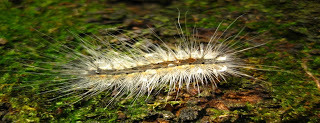 If it were real, could the gooseberry wife look something like this?
If it were real, could the gooseberry wife look something like this?In a Fortean Times letter (FT #225, 2007), Neil Powney recalled that his girlfriend Lyn, when aged 7-8 and living in the Corringham area of Essex three decades ago, was once startled to see a huge furry caterpillar crawling up a lavender tree less than 5 ft away from her in her parents’ back garden. She estimates that it was about 1 ft long, as thick as a rolling pin, and covered in 4-in-long hairs, dark brown-green in colour. As she watched, this extraordinary creature made its way up the tree’s trunk, and then across onto a panel of the adjacent fence, which it crawled along until it came to a gap that it squeezed through into the neighbouring garden. When Lyn looked over the fence, she could see the caterpillar making its way across the neighbour’s lawn. Lyn then ran inside her own house and fetched her mother, but when they came outside it had vanished. I wonder whether Lyn, as a child, may have mistaken for a single giant entity a colony of caterpillars moving together in formation, yielding a column or procession (which those of the processionary moths and certain other species do). Yet her view of it was at such close range that this does not seem a very satisfactory explanation. Thoughts, anyone?
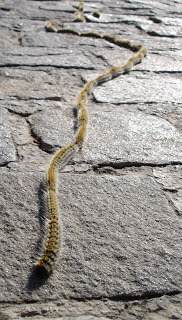 Pine processionary caterpillars Thaumetopea pityocampa photographed in their typical single-file procession (Elveoflight/Wikipedia)
Pine processionary caterpillars Thaumetopea pityocampa photographed in their typical single-file procession (Elveoflight/Wikipedia)No less intriguing, or perplexing, is the following report, which appeared in London's Observer newspaper during January 1852:
"In the Algerian paper we read that a hairy viper was seen a few days ago near Drariah, coiled round a tree. It resembled an enormous caterpillar, and was of a brownish-red colour; its length was about twenty-two inches. The moment it saw that it was observed, it glided into the brushwood, and all attempts to discover it were unavailing. The authorities of the Museum of Natural History of Paris have sent off orders to their agents in Algiers to get a specimen of this viper."
Orders or no orders, their agents clearly failed in their appointed task, because no-one seems to have heard anything more about Algeria's uniquely hirsute vipers. Interestingly, Central Africa is home to an unusual species known as the hairy bush viper Atheris hispida on account of its extremely keeled scales, whose long spiny projections give it a bristly, almost hairy appearance, but no such snake is known from North Africa.
 Hairy bush viper (Soulsurvivor08/Flickr)
Hairy bush viper (Soulsurvivor08/Flickr)Perhaps, therefore, it really was nothing more than an enormous caterpillar, but, if so, I can only presume that estimates of its size were greatly exaggerated.
At least I hope that they were - any butterfly or moth metamorphosing from a 22-in-long caterpillar would be a fearsome sight! Something more akin, in fact, to a Wonderland caterpillar than anything expected from Algeria, or even, indeed, the Isle of Wight.

Published on May 24, 2012 15:46
May 19, 2012
SAT-KALAUK - A BURMESE BLOODSUCKER

I have been collecting animal-themed stamps ever since my mother and grandmother introduced me to this fascinating hobby when I was still a small child in the mid-1960s. One of the first sets that they bought for me was one from North Vietnam, issued in 1965, which featured a selection of six unusual Asian mammals, and included the very striking species featured above. I had never previously heard of it, but its exotic image on that stamp has remained in my mind ever since I first saw it all those years ago. Little did I know, however, that one day I'd be writing about this selfsame species, and that it would prove to be the identity of a very sinister-sounding beast of the East.
One of mythology's most famous bloodsucking monsters is the evil vampire cat of Japan, a feline ghoul that drains the blood of its sleeping victims at night. Less well known is that there is a real-life equivalent of sorts. This is the sat-kalauk or nabashing of Myanmar (formerly Burma) - a strange cat-like creature that allegedly leaps onto the necks of sambur deer and sucks their blood.
According to the Annual Report on Game Preservation in Burma for the year ending 31 March 1938, one such beast, fixed firmly onto the throat of a sambur, was spied by a villager in the forests below the Maymyo Hills, but no-one appeared certain of its identity. Not long afterwards, however, the mystery was solved, following the capture of a sat-kalauk in the Indawgyi Forests of Myitkyina, northeastern Myanmar. In 1954, its species was formally identified in a Burmese Forester article by U Tun Yin as a yellow-throated marten Martes flavigula. This is a very large, strikingly coloured relative of the European pine marten M. martes and the American fisher M. pennanti, and is known to prey upon young deer. It also happens to be the species that appears in the Vietnamese stamp opening this ShukerNature post. Another cryptozoological creature was cryptic no more.
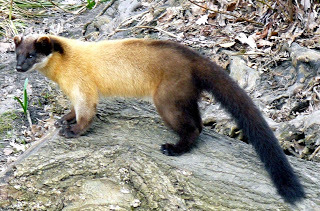 Yellow-throated marten (Altaileopard/Wikipedia)
Yellow-throated marten (Altaileopard/Wikipedia)
Published on May 19, 2012 19:36
May 15, 2012
EBONY ENCOUNTERS OF THE SERPENTINE KIND
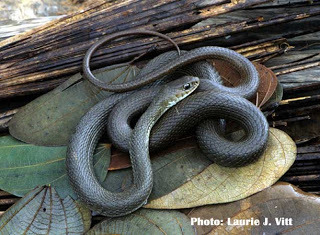 Melanistic specimen of the Patagonian green snake Philodryas patagoniensis (Laurie J. Vitt)
Melanistic specimen of the Patagonian green snake Philodryas patagoniensis (Laurie J. Vitt)Whereas some mysteries become less mystifying once investigated, others only become even more so – and the herpetological example under consideration here definitely belongs to the latter category.
As a child, I was bought a wonderful anthology entitled Animal Stories, published in 1967, whose contents had been chosen by Alan C. Jenkins. Within its covers, he had compiled a splendid collection of animal-themed fiction and non-fiction, including chapters extracted from a number of classic books, such as Gerald Durrell's The Bafut Beagles (1954), Jim Corbett's Man-Eaters of Kumaon (1944), Ernest Thompson Seton's Lives of the Hunted (1901), and W.H. Hudson's Far Away and Long Ago (1918).
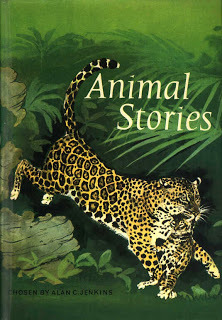
My favourite story in the entire anthology was a chapter entitled 'A Serpent Mystery', from the above-mentioned book by W.H. Hudson (in which he recalled his early life in the Quilmes, a borough in Argentina's Buenos Aires Province). Reading it, the mystery in question, namely the identity of a very remarkable snake that he had encountered on three separate occasions, seemed to have been solved by him at the end of the chapter. However, after returning to this story recently and investigating his claims concerning the snake, I have realised that the mystery may still be far from solved.

Hudson's 'Serpent Mystery' chapter can be summarised as follows.
Even as a boy, Hudson was familiar with the various ophidian species native to his home region, none of which exceeded 4 ft long, and he spent many hours exploring a weed-infested piece of waste ground at the far end of his family's plantation. One hot December day, while standing amid this wilderness, he heard a soft rustling sound near his feet, and, looking down, was startled to see a very long, slender, coal-black snake moving very slowly past him. He estimated its total length to be at least 6 ft, probably more, and he stared at it intently, remaining motionless until it finally vanished from sight among some long grass. What could it have been? Neither its colour nor its size matched that of any species that he had ever known or heard of existing in this area.
Initially, Hudson vowed never to return to this dangerous site, but his fascination with its unexpected inhabitant ultimately won the day, compelling him to venture back – and after numerous days of failure, he finally caught sight of the mysterious ebony-scaled serpent again, gliding languorously through the weeds in the very same spot as before. This time, however, Hudson was able to spy its destination – a hole in the ground, into which it passed until it was totally hidden from view. On many subsequent visits to the waste ground, he deliberately stood quietly near to this hole in the hope that sooner or later he would once more see its enigmatic owner, but the long black mystery snake never made an appearance.
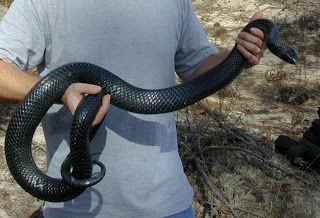 Did Hudson's ebony-scaled mystery snake look like this Eastern indigo snake?
Did Hudson's ebony-scaled mystery snake look like this Eastern indigo snake?Then one day, after having stood there yet again, and for some considerable time, but still without success, Hudson became bored, and chose instead to interest himself in observing a bat hanging from a twig just overhead. Concentrating upon the bat, he at first paid no heed to a sensation of pressure upon the instep of his right foot, but when the pressure increased, until it seemed as if a heavy metal bar were resting upon it, he casually glanced down to see what was responsible for this sensation – and was shocked to discover that it was none other than his long-sought-after black mystery snake, which was actually drawing its lengthy inky-black coils leisurely across his foot!
By standing in his present position, Hudson's foot was inadvertently blocking the snake's passage to its hole, and so rather than moving around the offending obstacle it had decided simply to take the shorter course, and pass directly over it! Thrilled, terrified, and tantalised in equal measures, Hudson remained immobile as coil after coil rippled like a sable stream across his foot, until at last their sinuous owner had re-entered its den undisturbed and unalarmed.
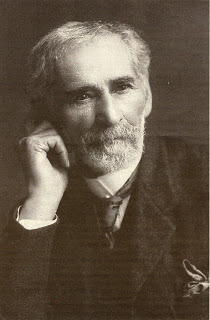 W.H. Hudson (1841-1922)
W.H. Hudson (1841-1922)Although Hudson returned many times afterwards, he never saw the snake again, and no-one whom he questioned about it had ever seen or heard of anything like it in that area of Argentina either. Subsequent investigations, however, led him to believe that it was a melanistic (all-black) specimen of a species that he referred to as Philodryas scotti. He claimed that this was a not uncommon Argentinian species, though not in his home region, and that it did indeed grow to 6 ft or more.
In addition, Hudson noted that two years before his three meetings with the black snake, a normal-coloured P. scotti specimen – one that he described as "a pale greenish-grey, with numerous dull black mottlings and small spots" - had been encountered by his sister as a small child (and swiftly dispatched by their horrified father), but until now had not been identified.
As noted earlier, one might assume from the above account that Hudson had duly solved the mystery of his black snake – but in fact nothing could be further from the truth.
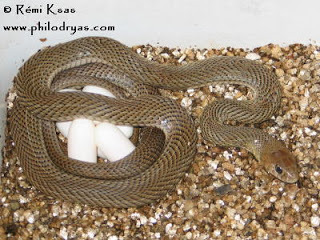 Patagonian green snake Philodryas patagoniensis (Kemi Ksas)
Patagonian green snake Philodryas patagoniensis (Kemi Ksas)To begin with: when googling Philodryas scotti, I discovered that only a single publication referred to it – and that publication was none other than Hudson's own book, Far Away and Long Ago. Could it be, therefore, that the name given by Hudson had been incorrect? Pursuing this possibility, I soon discovered that there was indeed an Argentinian species mentioned in numerous sources whose name differed by only a single letter – namely, Philodryas schotti (sometimes given as schottii). A species of venomous, rear-fanged colubrid, its common name is the Patagonian green snake, and nowadays it is referred to by many authorities as Philodryas patagoniensis.
Was this the true identity of Hudson's 'Philodryas scotti'? Certainly, photographs of P. patagoniensis correspond closely with Hudson's description of the snake encountered by his baby sister. Moreover, there are also a number of photographs online of melanistic specimens that readily recall Hudson's black mystery snake. However, P. patagoniensis does not normally exceed 5 ft.
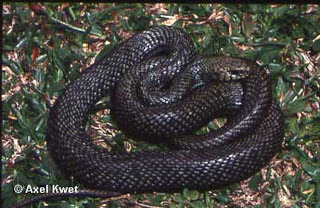 Melanistic specimen of Patagonian green snake Philodryas patagoniensis (Axel Kwet)
Melanistic specimen of Patagonian green snake Philodryas patagoniensis (Axel Kwet)Consequently, if the two snakes reported by Hudson did indeed belong to this species, either they were unusually lengthy or their size had been over-estimated by him. Some mutant gene alleles responsible for melanism are known to increase body size too, so assuming that Hudson had not over-estimated its length, this could explain the black snake's extra-large size, but not the normally-coloured specimen's.
So were these two snakes truly P. patagoniensis, or did they belong to a different species – and, if they did, which one? Perhaps, more than 90 years after the publication of Far Away and Long Ago, the last word has still to be said on the subject of W.H. Hudson's intriguing serpent mystery.
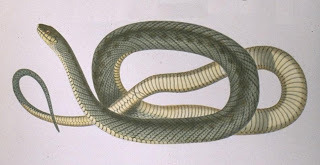 Colour engraving from 1858 of Patagonian green snake Philodryas patagoniensis
Colour engraving from 1858 of Patagonian green snake Philodryas patagoniensis
Published on May 15, 2012 13:39
April 30, 2012
WOLVERINE, WOLVERINE, WHERE HAVE YOU BEEN?
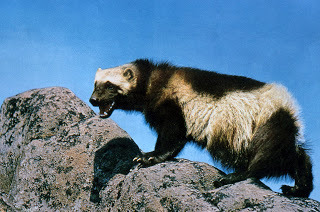
It's always a great feeling when the lost is found, when a mystery is solved – and especially so when the lost had been lost, and the mystery concerning it unresolved, for over 40 years.
Right from a very early age, I had always been fascinated by mysterious and mythological creatures, making my eventual cryptozoological career little short of inevitable. And so it was that a certain episode of a Western show that my family and I viewed one Sunday afternoon on British television during the mid-1960s, when I was around six years old, engaged my attention to a far greater degree than might otherwise have been expected, given the fact that, normally, the Western genre held little if any interest for me.
The episode in question concerned the stalking of a family living alone in the American wilds a century or so ago by a mystifying but greatly-feared beast of such rapacious, belligerent, yet elusive nature that it was referred to superstitiously by the local native American people as a devil (a name that, as far as I could recall, also featured in the title of this episode). They also called it by another, more exotic-sounding name, and, as in all the best suspense movies, the creature itself was never seen, until the very end. Instead, the viewer had to be content with savage growls, rustles in the undergrowth, and off-screen activity.
Finally, the 'devil' was lured close enough to be shot, and at the denouement it was revealed to be an unexpectedly large specimen of a creature not generally encountered in those parts. But what exactly was that creature? Only at the end was its English name finally given, and it proved to be a species that, as a young child, I had never heard of before – the wolverine.
 The wolverine, painted by John James Audubon
The wolverine, painted by John James AudubonKnown scientifically as Gulo gulo, native to boreal forests in northern North America and also northern Europe and northernmost Asia, the wolverine or glutton is the largest living terrestrial member of the mustelid family, growing to the size of a small bear. Moreover, it is infamously ferocious, powerful, intelligent, and tenacious, making it one of the most feared species of mammal throughout its range. Little wonder, then, that in the episode it had been referred to by the native people as a devil.
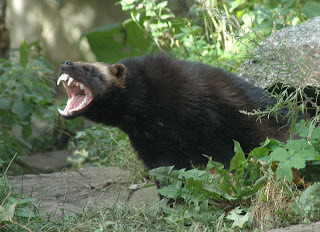 Beware the wolverine, my son! (with apologies to Lewis Carroll!)
Beware the wolverine, my son! (with apologies to Lewis Carroll!) This particular programme had a strong impact on me, as I had been enthralled waiting to discover what the mystery beast in it was, and I can remember watching it avidly a second time a couple of years or so later when the series in which it appeared was repeated on television (even though I now knew the creature's identity beforehand), but after that, nothing. As far as I am aware, neither the entire series nor this particular episode from it was ever broadcast on British television again. But what was the series?
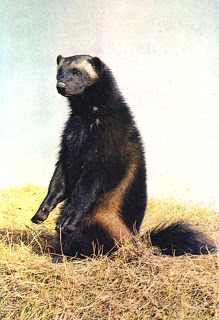 Wolverine postcard from my collection (Norfolk Wildlife Park)
Wolverine postcard from my collection (Norfolk Wildlife Park)The years passed by, and despite remembering the wolverine episode in great detail, I never could recall the name of the series itself, and whenever memories of the episode periodically came to mind I always promised myself I'd pursue this intriguing little mystery, but somehow I never did. Eventually, even the wolverine episode faded in my recollection until it became little more than a hazy, half-forgotten dream. And although I would often flick through books on vintage television, I never obtained any clues as to its series' identity.
Just like its subject, however, the wolverine episode was nothing if not tenacious, and recently it came to mind yet again – but this time, armed with the vast research power of the internet, I decided that the time had come to track down this cryptozoological tele-phantom once and for all. I began my search on YouTube, in the hope that the episode, or at least an excerpt or two from it, had been posted there. I knew that I could still remember enough details to be able to recognise it, should it be there. But despite using a variety of key words – 'Western', 'television', 'wolverine', 'devil', '1960s' – nothing promising came up.
 Wolverine at the Arctic Interagency Visitor Center, Coldfoot, Alaska
Wolverine at the Arctic Interagency Visitor Center, Coldfoot, Alaska So I turned my attention to Google, and used the same key words in its search engine. After a time, I thought I'd discovered it, but it was a false lead. Google had turned up an episode from 1963 called 'The Wolverine' in a Canadian series entitled 'The Forest Rangers', in which a ferocious wolverine turns up in Indian River (the fictional location where this series was set), killing all the livestock there. This plotline certainly compared closely with the programme that I had seen, and the creature was even referred to in it by the same exotic name that I now recalled from 'my' episode – carcajou, an Ojibway name. But when I researched 'The Forest Rangers' series, I discovered that its rangers-focused storylines didn't accord at all with those of the series that I had viewed all those years ago. Exit 'The Forest Rangers'.
Happily, however, my continued Googling did finally achieve the long-awaited success that I had been hoping for, because there, at last, on my computer screen, was the answer. The series, first broadcast in 1966, was entitled 'The Monroes', which was produced by Qualis in association with 20th Century Fox Television, and included Michael Anderson Jr and Barbara Hershey (playing the parent-substitute figures of big brother and sister) among its stars.
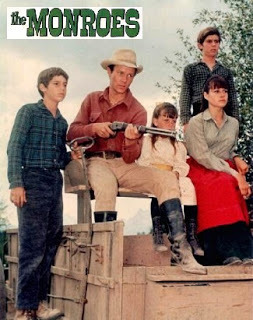
It centred around the story of five orphans (aged from 18 down to 6 years of age) trying to survive in 1876 as a family on the frontier in the area around what is now Grand Teton National Park near Jackson, Wyoming, after their father and mother had drowned.
 An official story book companion to 'The Monroes' (TheDamnÐœushroom-Flickr)
An official story book companion to 'The Monroes' (TheDamnÐœushroom-Flickr) Running for just a single season, 'The Monroes' consisted of 26 episodes – the fourth of which, entitled 'The Forest Devil', was the wolverine episode that had played such a key role in kindling my interest in cryptozoology as a youngster and had afterwards teased and tantalised my mind for over four decades.
And as if my solving this longstanding mystery from my childhood was not satisfying enough, I then discovered that the entire episode had actually been uploaded on YouTube, in five parts. Needless to say, and for the first time since the mid-1960s, I duly sat and watched, just as entranced now as I had been then, 'The Forest Devil' – made even more memorable this time by being able to view it in colour. For just like so many other families in Britain at that time, we'd only had a black-and-white television during the 1960s, so until now I'd never seen this programme in colour.
Returning when an adult to a television show, a book, or even a location that had been so appealing as a child does not always live up to expectations, with the memory of it sometimes proving to have been much more special than the reality. However, I'm happy to report that in the case of 'The Forest Devil', it was every bit as thrilling and enjoyable now, even in these jaded 2100s, as it had been for me back in the 1960s, when everything was still bright and fresh and new and exciting.

In terms of cryptozoological significance, rediscovering 'The Forest Devil' hardly compares, for instance, with my recent solving of the long-baffling Trunko case, nor would it rank alongside the refinding of the legendary thunderbird photograph (should this ever happen one day), but for me, it was just as eventful and satisfying. It also showed me that miracles, even if they are only very minor, personal ones, do indeed still happen in this mundane old world of ours. And that, if nothing else, is something worth treasuring.
If you'd like to view 'The Forest Devil' on YouTube, here it is in five clickable parts:
'The Forest Devil', Part 1
'The Forest Devil', Part 2
'The Forest Devil', Part 3
'The Forest Devil', Part 4
'The Forest Devil', Part 5
Published on April 30, 2012 07:45
April 28, 2012
IN TUNE WITH THE NEW GUINEA SINGING DOG
 An 11-month-old female New Guinea singing dog (Oldsingerman20/Wikipedia)
An 11-month-old female New Guinea singing dog (Oldsingerman20/Wikipedia)
In addition to the many feral (run-wild) domestic dogs of relatively recent origin and varied appearance present throughout New Guinea, there may still exist in the more lofty reaches of its eastern highlands a very primitive canine form of much greater antiquity and well-defined morphology – the New Guinea singing dog.
This interesting animal resembles a short, fairly thickset Australian dingo with a broad vulpine face and varying coat colour (most commonly brown), but with a noticeably bushy tail that it sometimes curls to one side over its rump. It also compares closely with the dingo in relation to certain cranial-dental ratios held to be of significance in canid classification. Recent genetic research has revealed that both singing dog and dingo date back at least 4000 years, making them among the oldest of the ancient domestic dog breeds.
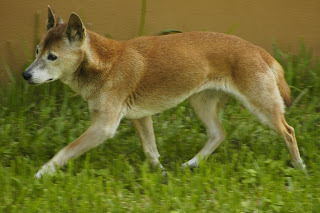 New Guinea singing dog, a very early surviving domestic dog breed (Valerie Abbott)
New Guinea singing dog, a very early surviving domestic dog breed (Valerie Abbott) It was originally made known to the western world as long ago as 1606, when Diego de Prado reported finding specimens in southeastern Papua, while voyaging through the Torres Strait separating Papua from Queensland, Australia. The first specimen examined scientifically, however, was one that had been shot and killed by Sir William MacGregor on Mount Scratchley at 7000 ft in 1897, whose alcohol-preserved skin and skeleton were then sent by MacGregor to the Queensland Museum.
In 1957, Dr Ellis Troughton, Mammal Curator at the Australian Museum, classed it as a distinct species, dubbing it Canis hallstromi, in honour of Sir Edward Hallstrom (President of the Taronga Park Trust), and in an attempt to initiate further studies of this hitherto largely-ignored form that would determine its precise taxonomic status. Troughton based his description of this new species upon a pair housed at Sydney’s Taronga Zoo. These had been received by Hallstrom in 1956 as a gift from Assistant District Officer J.P. Sinclair and Medical Assistant Albert Speer, who had obtained them while on patrol in the remote Lavani Valley in Papua's Southern Highlands District.
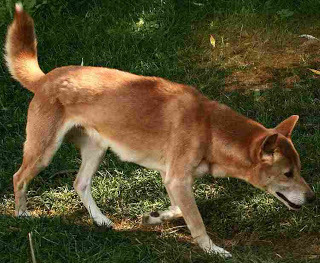 Long-obscure, the New Guinea singing dog has elicited significant taxonomic controversy (Patti McNeal/Wikipedia)
Long-obscure, the New Guinea singing dog has elicited significant taxonomic controversy (Patti McNeal/Wikipedia) In 1971 Troughton published another paper treating C. hallstromi as a valid species; but two years earlier, following detailed studies of its breeding and offspring, Dr W. Schultz had proposed that it should be incorporated within the domestic dog’s species (Zoologischer Anzeiger, 1969). This was widely accepted, and today the creature is most commonly considered to be a long-established feral breed of domestic dog (as is the dingo), although a few researchers still favour its delineation as a separate species. Taxonomically, it has been classified variously as Canis familiaris dingo, C. lupus dingo, C. f. hallstromi, C. l. hallstromi, and C. hallstromi.
 New Guinea singing dog with rare black-and-tan coat colouration
New Guinea singing dog with rare black-and-tan coat colouration In any event, Troughton’s paper remains a very important contribution. It contains one of the most detailed accounts of this little-known dog currently available, documents early descriptions, details its relationship with the New Guinea natives (who looked upon it as a valued food item), and, most memorable of all, reveals that it does not bark, but gives vent to a curious howling whine instead. "A sort of whistling-yodelling" is the description given to me by Dr Desmond Morris, who was Curator of Mammals at London Zoo during the period when Sir Malcolm Sargent's pair was living there (see later). This last-mentioned characteristic has earned C. hallstromi its most popular English name, the New Guinea singing dog, and has inspired many unusual myths concerning it.
 A New Guinea singing dog...singing! (R.G. Daniel/Wikipedia)
A New Guinea singing dog...singing! (R.G. Daniel/Wikipedia)According to some, these animals harbour the souls of dead tribesmen, who communicate with their living relatives via the dogs’ yodelling. Moreover, the natives believe that by listening carefully to the specific tones of a given dog, the identity of the dead tribesman speaking with its voice can be instantly recognized. Also, their vocal abilities have inspired an interesting legend in the mythology of Port Moresby’s Motu tribe, claiming that it was these dogs that brought the gift of speech to humanity. And in the vicinity of eastern New Guinea’s Mount Hagen, the native people imitate this creature’s whistling yodels as an effective means of communicating with one another over great distances.
 New Guinea singing dog at San Diego Zoo, California (Asim Bharwani/Wikipedia)
New Guinea singing dog at San Diego Zoo, California (Asim Bharwani/Wikipedia)In earlier days, singing dogs were rarely seen beyond their New Guinea homeland, but nowadays they are widely exhibited in zoos around the world and are kept as house pets in North America. Conversely, they may not even exist any longer on a wild-living basis in New Guinea – no confirmed sightings have been documented since the 1970s there. Having said that, in 1988 Australian zoologist Dr Tim Flannery observed a number of possible specimens at Dokfuma (sceptics, however, claim that these may have been hybrids with domestic dogs rather than pure-bred singing dogs).
 Murray, a pet New Guinea singing dog
Murray, a pet New Guinea singing dog On account of their name’s musical association, a pair of singing dogs was presented during the early 1960s as an undeniably original and delightfully appropriate gift to the eminent conductor Sir Malcolm Sargent, during one of his Australasian concert tours. Although Sir Malcolm became very fond of them, he had nowhere suitable to keep them, so in 1964 he donated the pair to London Zoo, where he visited them on several occasions thereafter, and where they soon became very popular attractions (raising a litter of cubs, containing some dingo blood). I can still readily recall my own first encounter with the London Zoo singing dogs, as it proved to be quite an unforgettable event.
 New Guinea singing dog at London Zoo, 1960s (Zoological Society of London)
New Guinea singing dog at London Zoo, 1960s (Zoological Society of London)As a child of about six or seven at the time, I had read all about them in various books and magazines with unbounded fascination, and implored my parents to take me to see these wonderful dogs that could sing. When I reached their enclosure, one of them was at that very moment entertaining an enraptured audience with a thrilling rendition in falsetto fortissimo, so I eagerly thrust my way through the throng to obtain a closer view — a little too close for comfort, as it turned out.
I can only assume that its impromptu concert had proven too demanding for its voice, because just as I reached the front of the crowd, the singing dog stopped singing, turned around, and coughed violently and with unerring accuracy directly into my face! What a way to end its canine concerto! Still in a state of shock, I was swiftly dragged away by my mother, who was convinced that I would surely develop some hideous tropical disease. Needless to say, I did nothing of the kind but, not surprisingly, the whole incident remains one of my more vivid if unusual memories of childhood!
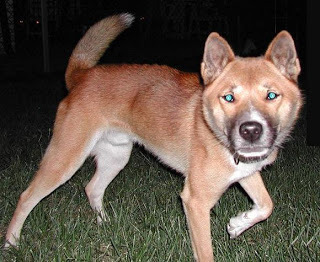 New Guinea singing dog - a yodelling dingo? (Tomcue2/Wikipedia)
New Guinea singing dog - a yodelling dingo? (Tomcue2/Wikipedia)Finally, I am greatly indebted to renowned zoologist Dr Desmond Morris, Curator of Mammals at London Zoo during much of the 1960s, for sharing with me the following priceless anecdote concerning these singing dogs. When Spike Milligan visited the zoo one day, Dr Morris showed them to him, and informed him that they belonged to Sir Malcolm Sargent. Spike’s opinion, given by way of reply, was, as always, purest Milliganesque:
“Their Bach is worse than their Bitehoven!”
 Still from video of Exmoor Zoo's New Guinea singing dogs (Gillian Abram/Graham Farr)
Still from video of Exmoor Zoo's New Guinea singing dogs (Gillian Abram/Graham Farr)The following delightful video of Exmoor Zoo's New Guinea singing dogs (the only ones currently on display in the UK) was filmed by Graham Farr and Gilliam Abram. Thanks very much, Graham and Gillian, for kindly permitting me to include your video here!
For further information concerning this enigmatic canid, I can heartily recommend the official website of the New Guinea Singing Dog Conservation Society - click here
This ShukerNature post is an expanded, updated version of the relevant section from my book Extraordinary Animals Revisited: From Singing Dogs To Serpent Kings (CFZ Books: Bideford, 2007).
Published on April 28, 2012 13:36
April 25, 2012
WAS THE IZCUINTLIPOTZOTLI A CANINE QUASIMODO?
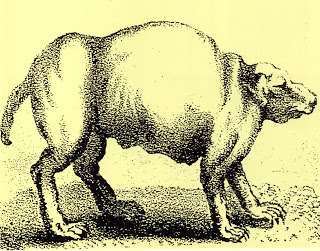 A 19th-Century engraving of the enigmatic but seemingly extinct izcuintlipotzotli
A 19th-Century engraving of the enigmatic but seemingly extinct izcuintlipotzotli
Sometimes, tragically, by the time that a cryptid attracts mainstream scientific attention, it is too late - the creature in question has already become extinct. Certainly, for example, it may be too late to secure a specimen of a still-unidentified creature formerly reported from Mexico - the unpronounceable izcuintlipotzotli - because it has not been reported for more than 150 years.
This bizarre beast first came to attention in 1780, courtesy of a tome entitled Historia Antigua de Mexico ('Mexico's Ancient History'), penned by Jesuit priest Father Francisco Javier Clavijero, a highly respected New World scholar. Inhabiting the Tarascan region of Michoacán in western Mexico, the izcuintlipotzotli was the size of a maltese terrier, with a small, wolf-like head, extremely short neck, lumpy muzzle, and small pendant ears. Strangely, its forelimbs were notably shorter than the hindlimbs, its skin was mottled with black, brown, and white spots, and - most striking of all - a grotesque hump (but possibly fatty rather than bony in composition) extended the entire length of its back, from its shoulders to its haunches. Indeed, part of its name, 'potzotli', translates as 'hunchback'.
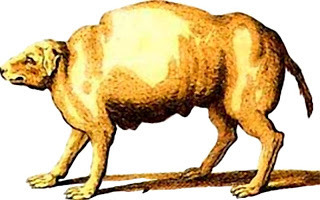
So singular was its appearance that some zoologists questioned the accepted belief that the izcuintlipotzotli was a breed of dog (albeit an emphatically homely one), even speculating that it may be some exotic species of rodent! However, the few known engravings of it that exist (such as the example opening this present ShukerNature blog post) suggest that this idiosyncratic entity was even less like a rodent than a dog.
Whatever it was, however, the izcuintlipotzotli is no more. What appears to be the last documented mention of such a creature occurred in 1843, within Frances Calderón de la Barca's book Life in Mexico, noting a dead specimen that she saw hanging from a hook near the door of an inn visited by her in the valley of Guajimalco. I am not aware of any preserved museum specimens either. If anyone reading this does have any additional information, however, concerning the seemingly demised izcuintlipotzotli, I would greatly welcome receiving it.
This post is excerpted from my book Mysteries of Planet Earth: An Encyclopaedia of the Inexplicable (Carlton: London, 1999).
Published on April 25, 2012 13:08
April 23, 2012
ST GEORGE AND A VERY POLYMORPHIC DRAGON
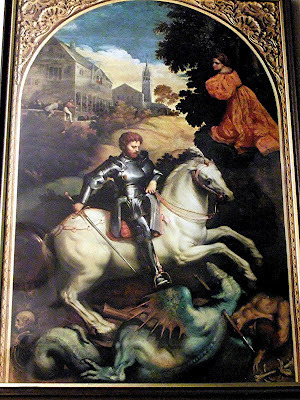 St George and the Dragon, painted as a wyvern-like creature by Paris Bordon (Dr Karl Shuker)
St George and the Dragon, painted as a wyvern-like creature by Paris Bordon (Dr Karl Shuker)Today, 23 April, is St George's Day. So here, by way of celebration, is the never-before-seen unedited version of my retelling of the famous legend of St George and the Dragon that appeared in my book Dragons: A Natural History (1995). Interestingly, as seen from the illustrations included here, down through the ages artists have visualised St George's reptilian foe in an unparalleled diversity of shapes, sizes, colours, and forms – everything, in fact, from a serpent dragon and lindorm to a wyvern and both wingless and winged classical dragons. Verily, a polymorphic dragon forsooth!
 Here's one I slew earlier! (Dr Karl Shuker)
Here's one I slew earlier! (Dr Karl Shuker)ST GEORGE AND THE DRAGON OF SILENE
It was the dawn of the 3rd Century AD - and now it was also the dawn of the doom-laden day that the king of Silene, in Libya, had long been awaiting with icy dread. For today, his beloved, only daughter would be sacrificed to the marsh-dwelling monster that had been terrorising his land for what seemed like an eternity of hope-enveloping horror.
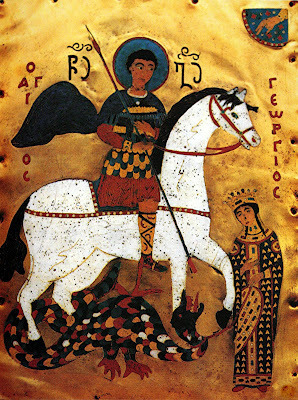 A 15th-Century plaque from Georgia, depicting St George slaying an unusually attractive dragon adorned with multicoloured tesselate scaling
A 15th-Century plaque from Georgia, depicting St George slaying an unusually attractive dragon adorned with multicoloured tesselate scalingHe could still recall with painful clarity this baleful beast's first appearance - a huge winged dragon with long, spiralling tail and olive-green, crocodilian scales, venturing forth from Silene's vast, unpenetrated swamplands many months ago, and choking the countryside with stifling, stench-laden clouds of poisonous vapour that blighted everything it embraced.
 Sir Edward Coley Burne-Jones portrayed St George's reptilian aggressor as a mail-encased crocodilian form of wingless classical dragon
Sir Edward Coley Burne-Jones portrayed St George's reptilian aggressor as a mail-encased crocodilian form of wingless classical dragonIn an attempt to quell its venomous violation of Silene, the local farmers had fed the monster with two sheep each day - a strategy that succeeded until the day came when there were no more sheep, whereupon the reptilian tyrant recommenced its own strategy, of devastation by asphyxiation. That was when, with heavy heart and mortified soul, the king had finally agreed to the daily sacrifice of a child, in the hope of assuaging the dragon's wrath long enough for some miracle to deliver Silene from this animate abomination.
 A rare beast indeed – this early depiction of St George and the dragon by an artist unknown (at least to me!) depicts the dragon as a winged lindorm!
A rare beast indeed – this early depiction of St George and the dragon by an artist unknown (at least to me!) depicts the dragon as a winged lindorm!The days, and the weeks, had fled by, and no miracle had appeared - until at last, the morning had come when it was now the turn of the king's own daughter, the fair princess Alcyone, to be tied to a stark wooden stake at the swamp's perimeter and surrendered to the loathsome creature concealed within it. No-one suspected that the miracle for which the king and everyone else in Silene had prayed so earnestly and for so long was about to occur.
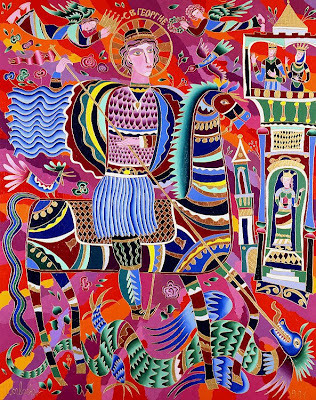 Yurigor Bachev's dazzlingly spectacular portrayal of St George battling a wyvernesque dragon
Yurigor Bachev's dazzlingly spectacular portrayal of St George battling a wyvernesque dragonBound upright to the stake, the princess had been standing there for only a few moments when her face grew ashen with fear, for she had heard the sounds of thunderous footsteps approaching ever nearer - assuredly the herald of her impending doom. Suddenly, however, she realised that the sounds were emanating not from the swamp ahead, but from the plains directly behind her, so she craned her neck back to discover what, or who, was responsible - and saw a tall knight, ensheathed in silver-grey armour with a breast-plate of white, upon which was emblazoned a scarlet cross. He had just dismounted from a cream-coated charger, and was carrying a long lance and a white shield, adorned once again with a cross of scarlet, as he walked briskly towards the tethered maiden.
 Leonard Porter's beautiful portrayal of the popular, romanticised image of St George and the dragon, with the latter as a small but archetypal winged classical dragon
Leonard Porter's beautiful portrayal of the popular, romanticised image of St George and the dragon, with the latter as a small but archetypal winged classical dragonIt did not require much explanation from the princess to acquaint the knight fully with the situation - and he in turn wasted little time in lengthy accounts concerning himself. His name was George, he had grown up in Cappadocia, eastern Turkey, and had been a soldier in the Roman army before becoming converted to Christianity. Now he served under no-one but God, spreading the Lord's word wherever he journeyed.
 This wonderful stained-glass window (artist unknown) overlooking the staircase at my home portrays St George's vanquished antagonist as a serpent dragon, sans limbs and wings
This wonderful stained-glass window (artist unknown) overlooking the staircase at my home portrays St George's vanquished antagonist as a serpent dragon, sans limbs and wingsA corporeal manifestation of evil, the dragon embodied everything that George had pledged to confront and conquer - and so, heedless of her pleas to save himself while there was still time, George untied the princess and stood in her stead, valiantly prepared for battle with her monstrous foe. He did not have to wait long. Without warning, the dense reed beds fronting a steaming quagmire close by were thrust apart, as a great reptilian head borne upon a powerful neck forced its way through them, followed by a massive body supported on four muscular limbs, and a lithe tail twisting furiously like a living corkscrew.
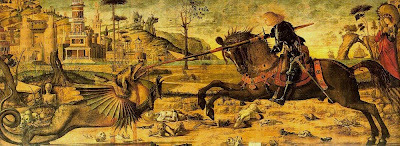 Carpaggio's breathtaking masterpiece, portraying the dragon in classical four-limbed winged mode
Carpaggio's breathtaking masterpiece, portraying the dragon in classical four-limbed winged modeDuring his travels through many strange lands, George had seen all manner of vile, misbegotten apparitions, but nothing prepared him for the wave of nauseous revulsion that swept over him as he beheld the dragon of Silene. Dripping with bilious, stinking slime that emphasised the livid hue of its scales, the hideous creature resembled a misshapen, obscene pile of rotting meat - green with putrefaction, oozing with decay, and reeking of death.
 Portrayed here by Jost Haller, the dragon is disconcertingly mammalian in form - so much so, in fact, that I find myself feeling a distinct pang or two of unease when viewing its demise
Portrayed here by Jost Haller, the dragon is disconcertingly mammalian in form - so much so, in fact, that I find myself feeling a distinct pang or two of unease when viewing its demiseLonging to avert his eyes and nose from such a sickening presence but intent upon vanquishing it from the face of the earth, George raised his right arm, and was just about to plunge his lance into the monster's head when two shapeless lumps flanking its neck's broad base suddenly burst into life - and to his bewilderment, George found himself surrounded by a flurry of blazing eyes. Everywhere he looked, they glowed and dazzled him, hypnotising him with their terrible allure - until he raised his arm again, and hurled the lance with all his might into the very heart of this spellbinding vista of unblinking, dancing orbs.
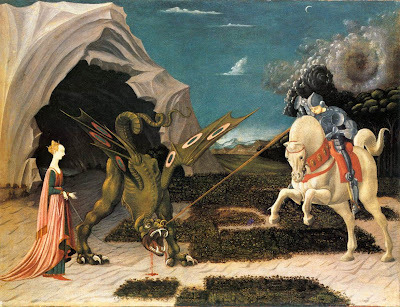 St George and the Dragon, painted as an ocellate-winged wyvern by Paolo Uccello
St George and the Dragon, painted as an ocellate-winged wyvern by Paolo UccelloA terrible scream rent the air, and the eyes vanished. No longer mesmerised by their movement, the knight looked down - and there lay the dragon, still alive but mortally wounded, his great lance protruding through its upper jaw and into its throat. And over its body, like an ornate shroud, lay its immense wings - whose bright ocellated markings, resembling an array of brilliant eyes, had so effectively bewitched George's vision.
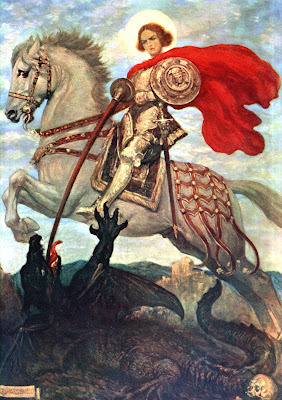 George, by George! - St George and a classical winged dragon, as painted by George Scott
George, by George! - St George and a classical winged dragon, as painted by George ScottRunning to him in delight came the princess Alcyone, and once they had tied the girdle of her dress around the subdued dragon's neck they returned on horseback to her father's castle, leading the monster alongside George's mighty steed. There, in return for the knight's promise to slay the dragon, the overjoyed king and subjects of Silene willingly agreed to be baptized by him and thus be converted to the Christian faith. True to his word, George beheaded their onetime oppressor forthwith, and after bidding farewell to Alcyone her valorous deliverer rode away, into a future that would shortly transform him into a Christian martyr, and, many centuries later, into a certain race of medieval Crusaders' patron saint - thereafter to be known forever as St George of England.
 St George and the Dragon, painted by Rogier van der Weyden
St George and the Dragon, painted by Rogier van der Weyden Of course, if you're wondering how I could have just stood by and allowed such a cryptozoologically-priceless specimen as a dragon be cruelly slain by St George, the answer is that I didn't - and here's the evidence! Cute little guy, isn't he? ;-)
 With a fiery little friend! (Dr Karl Shuker)
With a fiery little friend! (Dr Karl Shuker)
Published on April 23, 2012 08:59
April 17, 2012
FORTEAN TIMES REVIEWS MY TWO MOST RECENT BOOKS

The following reviews of my latest books - Karl Shuker's Alien Zoo (CFZ Press: Bideford, 2010) and The Encyclopaedia of New and Rediscovered Animals (Coachwhip Publications: Landisville, 2012) - appear in the May 2012 issue of Fortean Times (FT #287), together with competitions to win signed copies of each of them. Check out the reviews below:

Published on April 17, 2012 17:05
Karl Shuker's Blog
- Karl Shuker's profile
- 45 followers
Karl Shuker isn't a Goodreads Author
(yet),
but they
do have a blog,
so here are some recent posts imported from
their feed.



